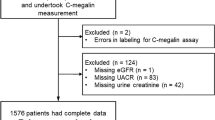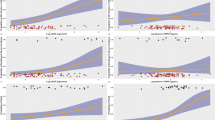Abstract
Aims
The aim of this cohort study was to evaluate the association between urinary levels of C-megalin, a full-length form of megalin, and kidney dysfunction progression and its dependence on the urinary albumin-creatinine ratio (UACR) in individuals with diabetes.
Methods
We enrolled 1,547 individuals with diabetes who visited the ambulatory clinic at Tenri Hospital, a regional tertiary-care hospital in Tenri City, Nara Prefecture, Japan, with an estimated glomerular filtration (eGFR) of ≥ 30 mL/min/1.73 m2. The hazard ratio (HR) and 95% confidence interval (CI) were estimated using Cox proportional hazard models to examine the association between urinary C-megalin levels and eGFR decline by ≥ 40% from baseline.
Results
Urinary C-megalin level was not associated with ≥ 40% eGFR decline in an age-, sex-, eGFR-, systolic blood pressure-, hemoglobin-, and UACR-adjusted model in the 1,547 patients enrolled in the study. However, urinary C-megalin levels were associated with a ≥ 40% decline in eGFR when accounting for the relationship between urinary C-megalin levels and UACR in the model. This association was UACR-dependent.
Conclusions
High urinary C-megalin levels were associated with progressive kidney dysfunction in individuals with diabetes, and this association was attenuated by high UACRs.


Similar content being viewed by others
Data availability
The datasets generated during and/or analyzed during the current study are not publicly available due to the need for participant privacy but are available from the corresponding author upon reasonable request.
References
Afkarian M, Zelnick LR, Hall YN et al (2016) Clinical manifestations of kidney disease among US adults with diabetes, 1988–2014. JAMA 316:602–610. https://doi.org/10.1001/jama.2016.10924
Nielsen R, Christensen EI, Birn H (2016) Megalin and cubilin in proximal tubule protein reabsorption: from experimental models to human disease. Kidney Int 89:58–67. https://doi.org/10.1016/j.kint.2015.11.007
Baines RJ, Brunskill NJ (2008) The molecular interactions between filtered proteins and proximal tubular cells in proteinuria. Nephron Exp Nephrol 110:e67-71. https://doi.org/10.1159/000161982
Christensen EI, Birn H (2001) Megalin and cubilin: synergistic endocytic receptors in renal proximal tubule. Am J Physiol Renal Physiol 280:F562–F573. https://doi.org/10.1152/ajprenal.2001.280.4.F562
Reisman SA, Chertow GM, Hebbar S et al (2012) Bardoxolone methyl decreases megalin and activates nrf2 in the kidney. J Am Soc Nephrol 23:1663–1673. https://doi.org/10.1681/ASN.2012050457
Nishiwaki H, Niihata K, Kinoshita M et al (2022) Urinary C-megalin as a novel biomarker of progression to microalbuminuria: a cohort study based on the diabetes Distress and Care Registry at Tenri (DDCRT 22). Diabetes Res Clin Pract 186:109810. https://doi.org/10.1016/j.diabres.2022.109810
Iida T, Hosojima M, Kabasawa H et al (2022) Urinary A- and C-megalin predict progression of diabetic kidney disease: an exploratory retrospective cohort study. J Diabetes Complications 36:108312. https://doi.org/10.1016/j.jdiacomp.2022.108312
Levin A, Agarwal R, Herrington WG et al (2020) International consensus definitions of clinical trial outcomes for kidney failure: 2020. Kidney Int 98:849–859. https://doi.org/10.1016/j.kint.2020.07.013
Levey AS, Gansevoort RT, Coresh J et al (2020) Change in albuminuria and GFR as end points for clinical trials in early stages of CKD: a scientific workshop sponsored by the National Kidney Foundation in collaboration with the US Food and Drug Administration and European Medicines Agency. Am J Kidney Dis 75:84–104. https://doi.org/10.1053/j.ajkd.2019.06.009
Kurita N, Kinoshita M, Fujimura M et al (2022) Association of urinary C-megalin with albuminuria and renal function in diabetes: a cross-sectional study (Diabetes Distress and Care Registry at Tenri [DDCRT 21]). J Nephrol 35:201–210. https://doi.org/10.1007/s40620-021-00995-2
Hayashino Y, Mashitani T, Tsujii S et al (2014) Serum high-sensitivity C-reactive protein levels are associated with high risk of development, not progression, of diabetic nephropathy among Japanese type 2 diabetic patients: a prospective cohort study (Diabetes Distress and Care Registry at Tenri [DDCRT7]). Diabetes Care 37:2947–2952. https://doi.org/10.2337/dc14-1357
Hayashino Y, Okamura S, Tsujii S et al (2018) Association between diabetes distress and all-cause mortality in Japanese individuals with type 2 diabetes: a prospective cohort study (Diabetes Distress and Care Registry in Tenri [DDCRT 18]). Diabetologia 61:1978–1984. https://doi.org/10.1007/s00125-018-4657-4
Ogasawara S, Hosojima M, Kaseda R et al (2012) Significance of urinary full-length and ectodomain forms of megalin in patients with type 2 diabetes. Diabetes Care 35:1112–1118. https://doi.org/10.2337/dc11-1684
Matsuo S, Imai E, Horio M et al (2009) Revised equations for estimated GFR from serum creatinine in Japan. Am J Kidney Dis 53:982–992. https://doi.org/10.1053/j.ajkd.2008.12.034
Miyamoto M, Kurita N, Suemitsu K, Murakami M (2017) Fistula and survival outcomes after fistula creation among predialysis chronic kidney disease stage 5 patients. Am J Nephrol 45:356–364. https://doi.org/10.1159/000466707
Sun Y, Goes Martini A, Janssen MJ et al (2020) Megalin: a novel endocytic receptor for prorenin and renin. Hypertension 75:1242–1250. https://doi.org/10.1161/HYPERTENSIONAHA.120.14845
Saito A, Nagai R, Tanuma A et al (2003) Role of megalin in endocytosis of advanced glycation end products: implications for a novel protein binding to both megalin and advanced glycation end products. J Am Soc Nephrol 14:1123–1131. https://doi.org/10.1097/01.asn.0000062962.51879.f8
Hori Y, Aoki N, Kuwahara S et al (2017) Megalin blockade with cilastatin suppresses drug-induced nephrotoxicity. J Am Soc Nephrol 28:1783–1791. https://doi.org/10.1681/ASN.2016060606
Acknowledgements
Members of the Diabetes Distress and Care Registry at Tenri Study Group: Hitoshi Ishii and Hirohito Kuwata (Department of Diabetology, Nara Medical University); Maki Fujimura, Kiyoko Takano, Satoru Tsujii, Shintaro Okamura, Satoshi Matsunaga, Yasuaki Hayashino, and Masako Kitatani (Department of Endocrinology, Tenriyorozu Hospital); Mako Kitatani (Shirakawa Branch, Tenri Hospital); Satoshi Matsunaga (Department of Hematology, Endocrinology and Metabolism, Niigata University Faculty of Medicine); Yaeko Kondo (Department of Diabetes and Clinical Nutrition, Kyoto University); Naotaka Fujita (Otsu Red Cross Hospital); Rei Ueda (Second Department of Internal Medicine, Faculty of Medicine, University of the Ryukyus); Rie Kawata (Sawa Hospital); Masami Tanaka (Tokyo Women’s Medical University Medical Center East); Tsuyoshi Mashitani (Mashitani Clinic); and Miyuki Furuya (Furuya Clinic). We would like to thank Yukari Moritsuji, Yuki Fujita, Noriko Nakamura, and Yoko Sakamoto (Department of Endocrinology, Tenri Hospital) for their clerical support. This study was funded by the Manpei Suzuki Diabetes Foundation and the Japan Society for the Promotion of Science (JSPS) KAKENHI [grant numbers 25460641 and 16K08897]. The funders played no role in designing the study; in collecting, analyzing, or interpreting the data; in writing the manuscript; and in the decision to submit the article for publication.
Author information
Authors and Affiliations
Consortia
Contributions
Conceptualization: NK; methodology: KN, HN, and NK; investigation: MK, KK, YS, SM, SO, ST, and YH; formal analysis: KN, HN, and NK; writing—original draft preparation: KN, HN, and NK; writing—review and editing: YH and NK; funding acquisition: YH; resources: NK, MK, KK, YS, SM, SO, ST, and YH; supervision: YH and NK.
Corresponding author
Ethics declarations
Conflict of interest
Kakuya Niihata, Hiroki Nishiwaki, Maki Kinoshita, Kentaro Kurosawa, Yui Sakuramachi, Satoshi Matsunaga, Shintaro Okamura, Satoru Tsujii, and Yasuaki Hayashino declare that they have no conflicts of interest. Noriaki Kurita has served as a senior scientist at the Institute for Health Outcomes and Process Evaluation Research (iHope International, a non-profit organization), but was not compensated for his contribution to this study. Denka Seiken Co., Ltd., measured urinary C-megalin; however, the company had no role in designing the study; in collecting, analyzing, or interpretating the data; in writing the manuscript; and in the decision to submit the article for publication. Denka Seiken Co., Ltd., contracted this study to iHope International.
Human and animals rights
This study conformed to the tenets of the Declaration of Helsinki and was approved by the institutional review boards of Tenri Hospital (approval no. 785) and Fukushima Medical University (approval no. 2966).
Informed consent
All patients provided informed consent to participate in this study.
Additional information
Publisher's Note
Springer Nature remains neutral with regard to jurisdictional claims in published maps and institutional affiliations.
This article belongs to the topical collection Diabetic Nephropathy, managed by Giuseppe Pugliese.
Supplementary Information
Below is the link to the electronic supplementary material.
Rights and permissions
Springer Nature or its licensor (e.g. a society or other partner) holds exclusive rights to this article under a publishing agreement with the author(s) or other rightsholder(s); author self-archiving of the accepted manuscript version of this article is solely governed by the terms of such publishing agreement and applicable law.
About this article
Cite this article
Niihata, K., Nishiwaki, H., Kinoshita, M. et al. Association between urinary C-megalin levels and progressive kidney dysfunction: a cohort study based on the diabetes distress and care registry at Tenri (DDCRT 24). Acta Diabetol 60, 1643–1650 (2023). https://doi.org/10.1007/s00592-023-02144-6
Received:
Accepted:
Published:
Issue Date:
DOI: https://doi.org/10.1007/s00592-023-02144-6




